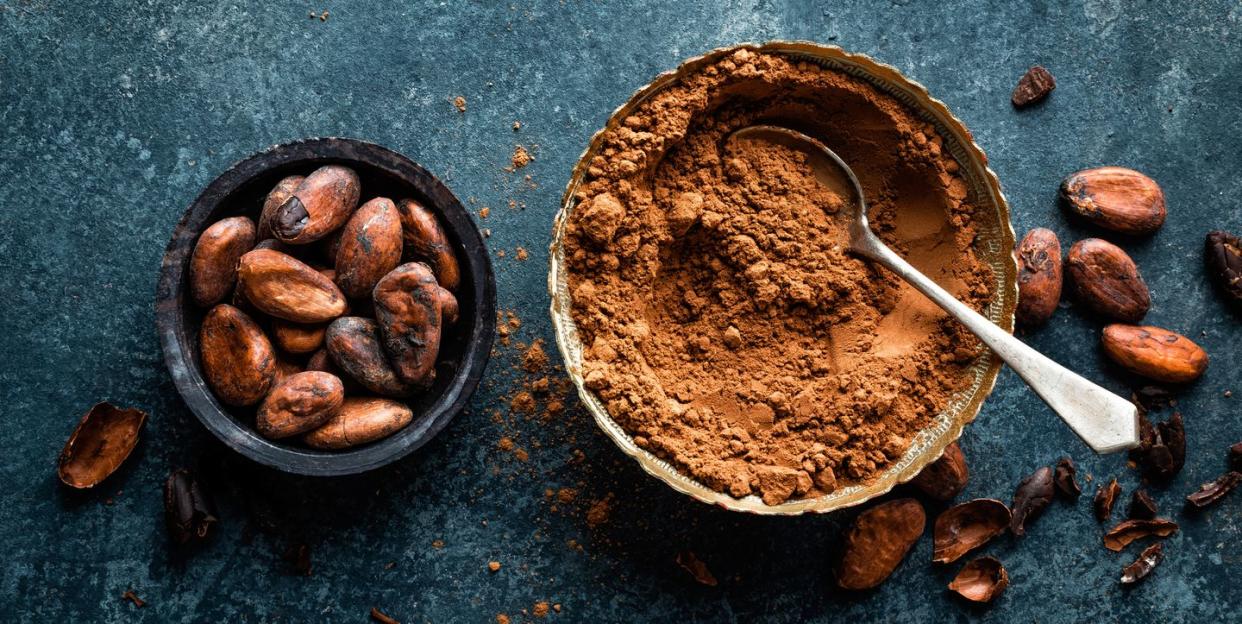If Chocolate Is Your Snack of Choice, You Might Want to Try Its Healthier Sibling: Cacao

"Hearst Magazines and Yahoo may earn commission or revenue on some items through the links below."
Due to COVID-19 stress, you might be craving the comfort of sweets more than usual. And while this is totally normal in such uncertain times, moderation is indeed key. If chocolate is your snack of choice, you might want to try it’s healthier sibling: cacao.
Derived from the same plant, cacao offers the taste and nutritional benefits of chocolate without all the added sugar and fat. As a matter of fact, cacao is the less processed form of cocoa, and it’s not just found in health food stores anymore. Cacao is popping up on supermarket shelves, in simple recipes, and even in other packaged food. In other words, it might be time to replace your chocolate stash with cacao.
What Is Cacao?
Cacao comes from the edible seed of the cacao tree, which is native to tropical regions such as Central and South America. After cacao beans are harvested from the tree, they are pulled from the shells and left in the sun to naturally ferment and dry.
Cacao nibs are crushed raw cacao seeds that have the same texture as coffee beans. Grinding the dried cacao seeds creates a cacao powder. Both cacao nibs and powder have the fruity taste of unsweetened dark chocolate with a hint of bitterness. Some recommend toasting the raw nibs in a dry skillet over medium heat to bring out the nutty flavor.
[Want to fly up hills? Climb! gives you the workouts and mental strategies to conquer your nearest peak.]
Cacao is known for its impressive nutrient profile, and many even call it a “superfood.” According to Ginger Hultin, M.S., R.D.N., Seattle-based registered dietitian and spokesperson for the Academy of Nutrition and Dietetics, cacao has calcium, iron, magnesium, zinc, and antioxidants called flavanols.
One serving—3 tablespoons —of cacao nibs contains the following:
150 calories
8 grams of fat
16 grams of carbohydrates
9 grams of fiber
4 grams of protein
0 grams of sugar
How Is Cacao Different Than Chocolate?
The word “cacao” may sound familiar to you because it comes from the same tree used to make cocoa and chocolate. “Though some people use the terms interchangeably, cacao generally refers to the raw bean and powder, while cocoa has been roasted and alkalized to reduce acidity,” says Hultin. She adds that the processing of cacao to cocoa reduces the antioxidant capacity.
Cacao nibs are finely ground to form something called a “cocoa mass” (a.k.a. cocoa liquor). This cocoa mass is then placed under extremely high heat to produce cocoa powder and cocoa butter. Dark chocolate is made from these byproducts in addition to sugar. Milk powder is added to the final product to make milk chocolate. “Once the solids and butter are combined in the desired portions and sugar is added, you have a chocolate product,” says Hultin.
One serving—1 tablespoon—of dark chocolate chips contains the following:
80 calories
5 grams of fat
8 grams of carbohydrates
1 gram of fiber
< 1 gram of protein
6 grams of sugar
How to Use Cacao in Cooking
It’s quite easy to cut back on added sugar in recipes by substituting cacao nibs or powder for chocolate chips or cocoa powder. Here are some simple ways to add more antioxidant-rich cacao to your daily foods.
1. If you’re a fan of mocha, spice up your morning coffee with a scoop of cacao powder. Since many coffee beans already have chocolate-y notes, cacao powder will amplify that flavor.
2. Use cacao nibs in energy ball recipes. Most homemade bites contain dates for sweetness, which pairs nicely with the slight bitterness of cacao nibs. Try this Cherry Cacao Energy Bite recipe to keep on hand for nourishing preride fuel.
3. For an even simpler preride snack, top a date with a scoop of peanut butter and sprinkle cacao nibs on top—it tastes similar to a peanut butter cup.
4. If you’re a chocolate smoothie fan (who isn’t?), use cacao powder instead of cocoa powder. For a simple postworkout smoothie, combine 1 banana with 1 tablespoon of cacao powder and ? cup Greek yogurt and ice. Blend until smooth.
5. Hultin recommends putting cacao powder in your chia seed pudding mixture. Combine 2 ? tablespoons of chia seeds, 1 cup of milk, 1 tablespoon cacao powder, and 1 tablespoon maple syrup in a mason jar, then stir and refrigerate overnight. The next day, you’ll have a low-sugar, chocolate-y pudding.
6. Spice up your morning oatmeal or overnight oats with cacao nibs or powder. Add a tablespoon of powder to an oatmeal or overnight oat recipe to make the oats taste like chocolate. Or sprinkle the nibs on top for some crunch.
7. Make your own sweet and savory trail mix with cacao nibs. Combine your favorite savory options, like salted nuts, popcorn, and pretzels with sweet options, like cacao nibs, raisins, and other dried fruits.
8. You can also use cacao powder to bake chocolate-flavored foods, like breads, brownies, muffins, cakes, and cookies, according to Hultin. Substitute cacao powder for cocoa powder in a 1:1 ratio.
9. Make a homemade, low-sugar hot chocolate by combining 1 cup of milk with 1 to 2 tablespoons of cacao powder and 1 teaspoon of sweetener (like honey or maple syrup). Microwave for 1 to 2 minutes until it’s warm.
You Might Also Like